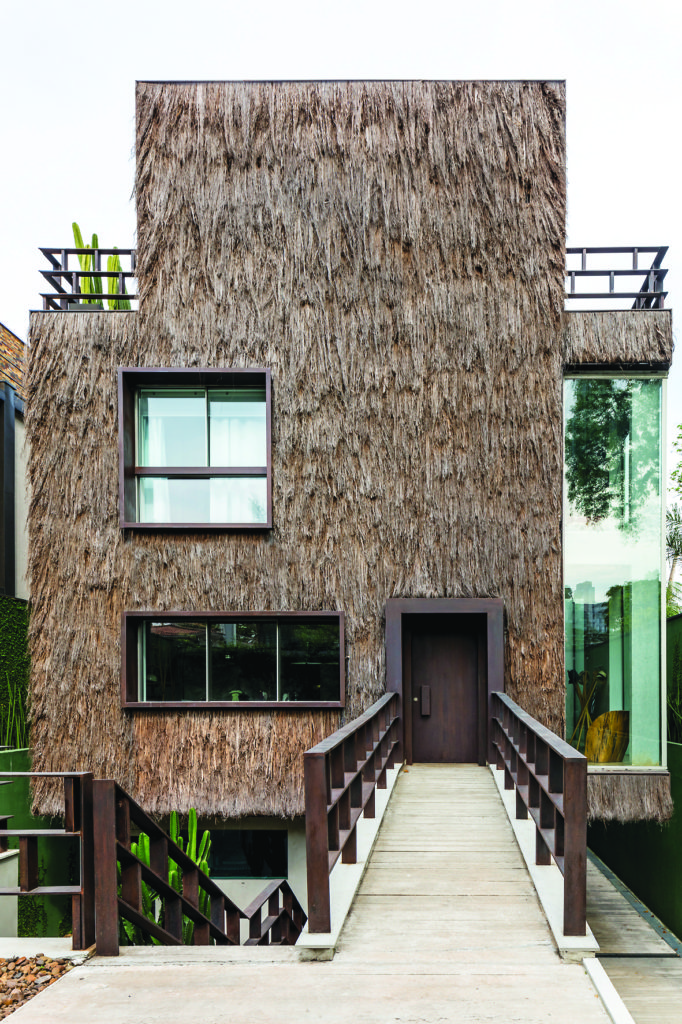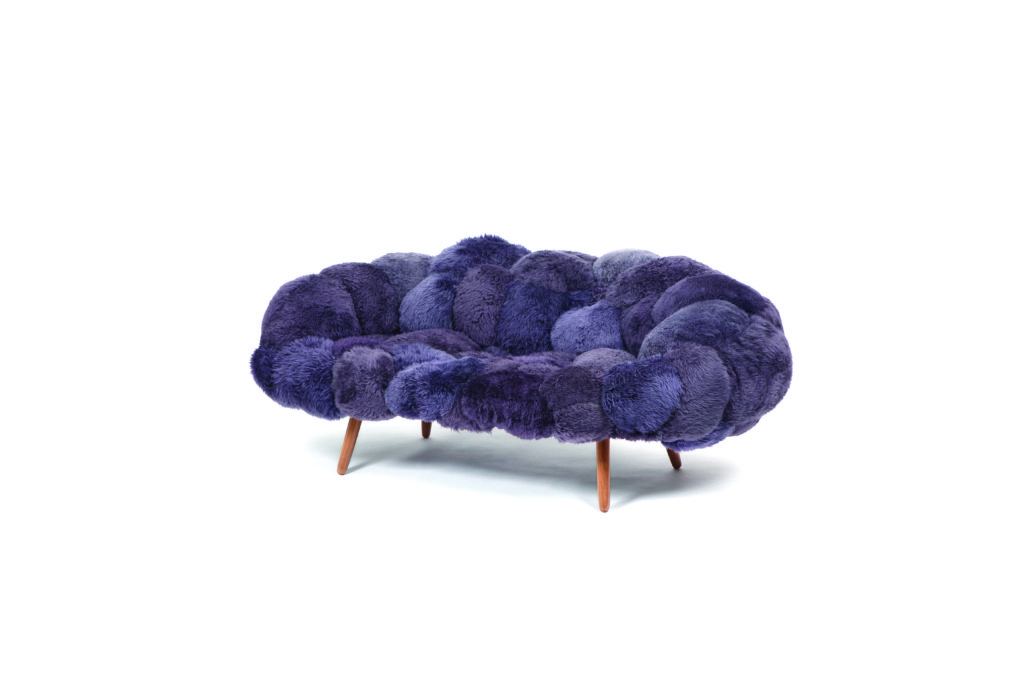 Branches sofa, 2017. Bronze and woven fabric. Courtesy Friedman Benda and Estudio Campana/Fernando Laszlo Photo
Branches sofa, 2017. Bronze and woven fabric. Courtesy Friedman Benda and Estudio Campana/Fernando Laszlo Photo
Feature
Serious Irreverence: The Campana Brothers
THROUGHOUT THEIR ALMOST THIRTY-FIVE years working together, the Brazilian design duo Humberto and Fernando Campana (generally known as the Campana Brothers) have developed an oeuvre with an appeal that is at once universal, democratic, popular, and sophisticated. Their imaginative creations find inspiration in unexpected places, are often made from repurposed materials, and always have a story and poetry all their own— the narrative quality as important as the function. The design has a definitive Brazilian flavor, but one that crosses over easy regional stereotypes, smoothly connecting rural and urban, local and global. Free of any restraints, their designs aim to engage at an emotional level.

Fernando (left) and Humberto Campana, 2017. Courtesy Estudio Campana/Fernando Laszlo Photo
Though their workshop, Estudio Campana, in São Paulo, is certainly out of the mainstream—they have stayed close to their roots—they are represented in the collections of the Metropolitan Museum of Art and the Museum of Modern Art (MoMA) in New York, among other institutions, and their work has been shown at the Design Museum in London, the Musée des Arts Décoratifs in Paris, and elsewhere. The best-known pieces are instantly recognizable as theirs and justly famous—among them the Favela chair, the Teddy Bear Banquete chair (with its several other iterations that include dolls and stuffed- animal pandas and dolphins), and the Sushi chair. The work shown at the Musée des Arts Décoratifs, and later in an exhibition at the David Gill Gallery in London, was called “Brazilian Baroque”; it is glamorous, exotic, evocative, and provocative—with alligators swarming up a candelabra, flora and fauna and human forms and faces creating the pattern for an ornamental chandelier. Besides David Gill, the Campana Brothers are represented at Friedman Benda in New York, Carpenters Workshop Gallery in Paris, and Giustini / Stagetti Galleria O. Roma in Italy. It should also be noted that among their earliest patrons and proponents was design tastemaker Murray Moss, who showed their work in both New York and his short-lived Los Angeles gallery.

Assimétrica cadeira (Asymmetric chair), made in collaboration with Tok&Stok, 2017. Fiberboard with polyurethane paint finish. Courtesy Tok&Stok
A closer look at the Campanas’ beginnings helps explain the roots of their rich, vivid inspiration that breaks with strict, closed-in design theories. Born in 1953 (Humberto) and 1961 (Fernando), they came of age at a difficult time in Brazil, the era when military dictatorships weighed heavily on the country’s spirit, particularly affecting the ambitions and artistic visions of its youth.
But the two young Campanas were exposed to a wealth of cultural stimulation that helped shape their vision toward a more hopeful and imaginative future. They grew up in Brotas, a rural small town some 160 miles from São Paulo. Their parents’ commitment to showing their sons the world beyond the small town, however, gave the brothers an informal education that would sow the seeds for the groundbreaking creativity to follow.

The designers’ first architectural commission was a private residence in São Paulo, 2015. Courtesy Estudio Campana/Leonardo Finotti Photo
The brothers read about the construction of Brasília on the pages of Life magazine’s Spanish edition (“I remember seeing the black-and-white photos of Oscar Niemeyer’s buildings going up and being fascinated by them,” Humberto recalls) and kept up with the latest Italian neorealist cinema. “It was along the lines of Cinema Paradiso: the local movie theater owner would bring the latest important films, by Fellini, Antonioni . . . films by Polanski too. And he would bring them by train from São Paulo,” Fernando says. “I remember also going to São Paulo with my father to see Stanley Kubrick’s 2001: A Space Odyssey when it came out.”
In spite of early artistic aspirations (both brothers wanted to be actors), they ended up opting for safer careers—architecture for Fernando and law for Humberto. Visiting an architect friend in the northeastern state of Bahia during a post-graduation break from big-city São Paulo, Humberto started making shell-decorated mirrors and accessories for one of his friend’s clients. Energized by the newfound pleasure of creating something original with his own hands, he returned to São Paulo and started a studio. “I was not an artist, but I was in search of something—learning as I was doing, looking at things,” Humberto recalls of that period. Not long afterward, Fernando joined him, initially helping with office duties. But soon, inspired by an internship at the 1983 Bienal de São Paulo, where he was ex- posed to the works of such artists as Keith Haring, Anish Kapoor, Jean-Michel Basquiat, and Kenny Scharf, Fernando began to make valuable contributions to the designs, thus starting the symbiotic, twin-like (despite their eight-year age gap) creative partnership. One of their first projects to get noticed was the 1989 collection Desconfortáveis (Uncomfortables), in which they treated each chair not just as a sitting piece but as an object with its own distinct personality.

Bolotas sofa, 2015. Sheep’s wool and natural Brazilian wood. Courtesy Carpenters Workshop Gallery
It didn’t take long for their work to receive wider attention. They were featured in Domus magazine in 1994, and then curator Paola Antonelli showcased their work in Projects 66: Campana/Ingo Maurer, a 1998 exhibition at the Museum of Modern Art, pairing pieces by the up-and-coming duo with ones by renowned lighting designer Ingo Maurer and finding common ground in their unique storytelling approaches. The Vermelha chair, displayed in the MoMA show, remains their best seller almost two decades later.

Edward Scissorhands side table in black, 2012. Bronze and Portoro marble. Courtesy David Gill Gallery
The exposure at MoMA brought the Campanas onto a new playing field, with manufacturers such as Edra, Cappellini, and Vitra soon finding their way to the São Paulo studio with collaboration offers. “From each of these collaborations we learned something,” Humberto says. “With Louis Vuitton, for example, a brand with such history of high craft, it was an education on the art of handcraft. Each detail, whether a zipper or colors to be used is questioned, discussed thoroughly.”

Detail of Sushi buffet, 2011. Carpet, rubber, EVA, fabric, ESTELA, and brass. Courtesy Carpenters Workshop Gallery
The brothers have also begun to design interiors and more recently, architecture—a house in São Paulo. It was a chance for Fernando to put his architectural knowledge to use. “So many decades after graduating, there I was, translating architectural basics to both Humberto and the client,” he says. One of the design’s main features is pure Campana Brothers: on the north facade, which faces the intense Brazilian sun and also a busy street, they covered a traditional brick wall with thatch, providing both insulation and an acoustic barrier. A material commonly found in indigenous architecture throughout Brazil finds an urban, functional application—the regional elegantly translated to the city.
But beyond their celebrated projects, the socially conscious side of design is what most interests the Campanas today. Fernando observes: “I think designers are now more interested in helping the planet than being superstars. It’s about offering new answers, with more dignity, to the challenges we see in the world. There’s so much that can be done, there’s such a vast array of opportunities that design can have an effect on. Partnering with communities in need is one of these ways.”

The reception area at the NEW Hotel in Athens, 2011. Courtesy Design Hotel™
Working with communities and nonprofit organizations has also given the brothers a chance to do some design-related soul searching. “When we did the Favela chair, we took inspiration from the favela ingenuity, we expressed that in design form, but we were not close to that world, and that has always bothered me,” Humberto says. “Some even criticized us for that, and I was never sure how to answer. The last years, through these experiences, I feel the answer is becoming clear.” To further develop this side of their practice, in 2009 the brothers founded the nonprofit Campana Institute, one of the main missions of which is to create collaborative agreements between companies and social-support outreach organizations, such as the Sebrae Reference Center for Brazilian Crafts (CRAB, in Rio de Janeiro), the Research Institute for Innovation and Technology (IPTI, São Paulo), and the social assistance organization Oratório São Domingos.

Cocoon, from Louis Vuitton’s Objets Nomades collection, 2015. Vacuum-molded fiberglass, calfskin, and quilted leather, with gilt-steel and brass hook. Courtesy Louis Vuitton/Patrick Galabert Photo
They have also recently experimented with creating more affordable products, fashioning a line for an Ikea-like Brazilian chain called Tok&Stok. “It felt it was the right time to do this project, that we were ready—the thirty-four years of experience had prepared us to do a furniture line that was inexpensive and practical,” Humberto says about the collection, which launched earlier this year. “We were constantly checking in with their production team on the cost estimates of the designs we were proposing, to keep the pricing as accessible as possible.” Inspiration came from construction sites and the improvised design found there: for example, taking two disjointed pieces of wood to make a worktable to use on-site. The resulting Tok&Stok tables, desk, chairs, and bookshelves have very simple lines—minimalist but with a slight irregularity to the geometry that produces a dynamic liveliness.
Next for Fernando and Humberto is a special creative indulgence. Coming full circle to their early days, the two brothers will flex their conceptual artistic muscles with an exhibition called Hybridism, on view at Friedman Benda in New York from September 7 to October 14. If their work often walks the fine line between the poetic and the functional, here they tip the scale toward the expressive. The exhibition will be an immersive environment composed of sculptural elements inspired by the brothers’ state of mind as they navigate the current global moment. The work to be shown draws on experiences that have affected the brothers in a deeply personal way, culminating in this introspective moment in their career—from Humberto’s impressions when running in São Paulo’s Parque Ibirapuera (“As I come across branches and tree trunk debris there I can’t help but imagine their creative possibilities,” he says) to the duo’s personal take on nature’s presence in the city.

Vermelha armchair, 1998. Rope woven around an aluminum and steel frame. Courtesy Espasso London
“After so many years designing, we wanted to have the pleasure of doing something non- functional,” Humberto explains. “We wanted to do something that could express this moment that we are living, the planet, the political situation in the world. We wanted to bring all this convoluted world into this project. Our work sometimes touches on the surreal, and we wanted to bring in this world of dreams, lyrical. Sure, some pieces will still have a utilitarian aspect, but through the art filter.” Summing up both the exhibition and the political moment, Humberto says: “Although politicians today want to build borders, we artists want to create bridges. The creativity of this century is about opening borders between disciplines.”

Cake stool, 2008. Stuffed animals hand-sewn on canvas over a stainless-steel structure. Courtesy Carpenters Workshop Gallery












